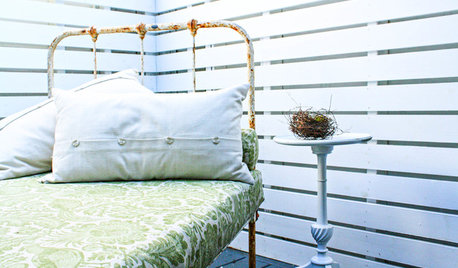First Batch of Crock Pickles (ten days in...)
john_scott
15 years ago
Related Stories

KITCHEN DESIGNHouzz Call: Tell Us About Your First Kitchen
Great or godforsaken? Ragtag or refined? We want to hear about your younger self’s cooking space
Full Story
GARDENING GUIDES10 Easy Edibles for First-Time Gardeners
Focus on these beginner-friendly vegetables, herbs, beans and salad greens to start a home farm with little fuss
Full Story
HOUSEKEEPING7-Day Plan: Get a Spotless, Beautifully Organized Living Room
A task a day sends messes away. Take a week to get your living room in shape
Full Story
KIDS’ SPACES7-Day Plan: Get a Spotless, Beautifully Organized Kids’ Room
Turn chaos into calm one step at a time in children’s rooms
Full Story
GARAGESRoom of the Day: Detached Garage Turned Teen Cave
New room serves up Ping-Pong, disc golf and board games, and hosts movie nights and sleepovers
Full Story
LIFETable Manners for Modern-Day Dining
Elbows and cell phones? Maybe. Forgetting to say 'thank you'? No way. Our mealtime etiquette guide takes the guesswork out of group dining
Full Story
FEEL-GOOD HOMESimple Pleasures: Get Cozy on a Cold Day
Some things are best when the weather is bad. Heat up some cocoa and join the discussion
Full Story
GREEN BUILDINGLet’s Clear Up Some Confusion About Solar Panels
Different panel types do different things. If you want solar energy for your home, get the basics here first
Full Story
MOST POPULAR10 Steps to a Happier Weekend
Savor your precious days off while still checking off to-do’s by following this simple plan
Full Story



readinglady
john_scottOriginal Author
Related Discussions
What day of Linda Lou's Sweet Pickles are YOU on??
Q
Old Crock Pickle Recipe Safe?
Q
What do I use to make pickles in?
Q
crock pickels raves
Q
jimster
readinglady
jimster
john_scottOriginal Author
readinglady
john_scottOriginal Author
john_scottOriginal Author
readinglady
john_scottOriginal Author
ksrogers
jimster
ksrogers
readinglady
john_scottOriginal Author
readinglady
john_scottOriginal Author
ksrogers
john_scottOriginal Author
ksrogers
all_organic_justin
dgkritch
john_scottOriginal Author
dangould
dgkritch
readinglady
ksrogers
dgkritch
john_scottOriginal Author
ksrogers
organic_stevej
john_scottOriginal Author
readinglady
john_scottOriginal Author